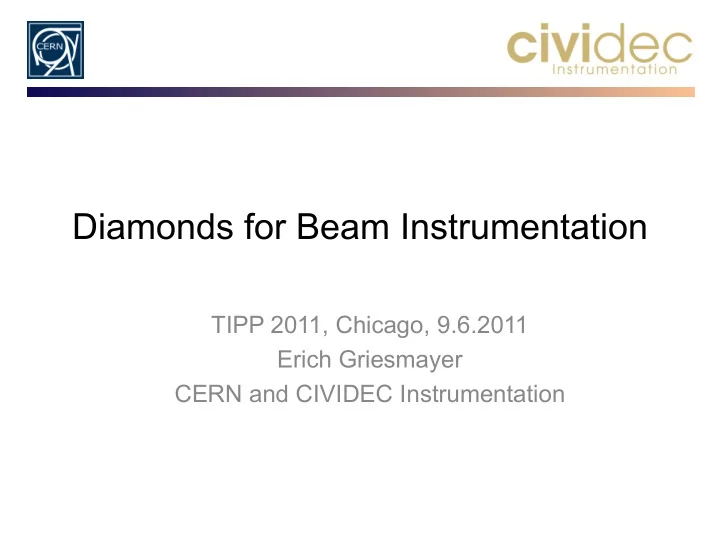

Diamonds for Beam Instrumentation TIPP 2011, Chicago, 9.6.2011 Erich Griesmayer CERN and CIVIDEC Instrumentation
Overview • Diamond Detectors • Physics • Application Examples • Summary
The Diamond Detector
Substrate Diamond Substrate: pCVD = 10x10 mm 2 x 0.5 mm sCVD = 5x5 mm 2 x 0.5 mm Next transparency 10 mm
pCVD Substrate Crystal boundaries, 100 – 200 um Charge-collection distance 200 um Trapping Reduction of ionization charges 500 um
Diamond Detectors pCVD sCVD
Diamond Beam Monitor Detector AC/DC Splitter 2 GHz Amplifier
Physics
Principle of Ionization 13 eV/eh-pair 1.6 fC/MIP
Modes of Operation
Proton Interaction E > : protons traverse detector E < : protons penetrate the detector (calorimetric mode) Direct measurement of the ionization charge. Single protons, efficiency = 100%
Proton Interaction
Proton Interaction
Proton Interaction Absorption Traversing
Proton Interaction Single particles
Proton Interaction Particle bunches Single particles Single particles Absorption Absorption Traversing
Proton Interaction ISOLDE P.T. LHC TEVATRON Particle bunches Single particles Single particles Absorption Absorption Traversing
Electron Interaction E > : electrons traverse detector E < : electrons penetrate the detector (calorimetric mode) Direct measurement of the ionization charge. Single electrons, efficiency = 100%
Electron Interaction
Electron Interaction Particle bunches Single particles Single particles Absorption Absorption Traversing 400
Neutron Interaction : Converter foil (B, Gd) and measure n a conversion products : Direct measurement of n a interaction of neutrons and detector Direct and indirect measurement of the n a ionization charge. Single neutrons, efficiency << 100% Neutron flux, efficiency = 100%
Photon Interaction : Photo excitation current Fluorescence monitors Ionization direct measurement, single photon detection Direct and indirect measurement of the ionization Direct measurement of the excitation Single photons, efficiency << 100% Photon flux, efficiency = 100%
Photon Interaction Excitation Ionization per 100’000 photons
Applications
Beam Instrumentation Detectors Protons - Beam Loss / Position / Profile Monitors Electrons - Beam Loss Monitors Photons - Beam Position Monitors (SLS, XFEL) Neutrons - Flux monitors (14 MeV fusion, radiation protection)
Application Example 1: PROTONS
Proton Therapy IBA Cyclotron in Orsay
Proton Therapy Energy calibration 50 MeV – 200 MeV IBA Cyclotron
Proton Therapy Beam structure 200 MeV protons, 106 MHz RF 100 mV/div 20 ns/div 9 ns RF period IBA Cyclotron
Proton Therapy Phase measurement 200 MeV protons, 106 MHz RF 10 ns/div
Proton Therapy Phase measurement 200 MeV protons, 106 MHz RF 10 ns/div 10 ps phase resolution 3 ° = 80 ps phase stability IBA Cyclotron
CERN ISOLDE – Heavy Ions
Heavy Ions Calorimetric spectroscopy 23 MeV C-ions 10 ns/div dE/E = 0.6% 50 mV/div Energy resolution Energy REX ISOLDE
LHC - Diamond Beam Loss Monitor LHC – Collimation Area – IP7
LHC - DBLM Unexpected beam abort (“UFO”)
LHC - DBLM 1 ms DBLM Ionization Chambers
LHC - DBLM 1 ms Zoom for next transparency DBLM Ionization Chambers
LHC - DBLM Zoom x10 100 us
LHC - DBLM Zoom x100 10 us
LHC - DBLM Zoom x1000 1 us
LHC - DBLM Zoom x10’000 100 ns
Application Example 2: Neutrons
Neutron Measurement n_TOF experiment at CERN: thermal to GeV neutrons
Neutron Measurement 6 MeV to GeV neutron time-of-flight 500 us/div 200 mV/div n_TOF at CERN
Neutron Measurement Measurement of n a and n p interactions n a n p Pulse shapes of interactions
Application Example 3: Photons
Medical LINAC AKH Vienna X-rays: 6 MV – 25 MV Dose-rate: 4 Gy/min Courtesy: D. Georg Diamond Detector Water phantom
10 MeV Photons Depth-dose profile measurement 2.5 ms bunch rate 1% agreement with a reference Single photon Thimble Ionization Chamber bunch of 2 us
Summary • Radiation resistance • Fast 10 ps time resolution, 360 ps for single particles • High sensitivity single particles with +40 dB • High dynamic range attenuation -40 dB • Protons – electrons – neutrons – photons • BLM, BPM, Counter, Spectroscopy, Phase • Many other potential applications…..
Conclusion
Thank you for your attention !
CVD Parameter 52
Radiation Hardness 24 GeV protons
Recommend
More recommend